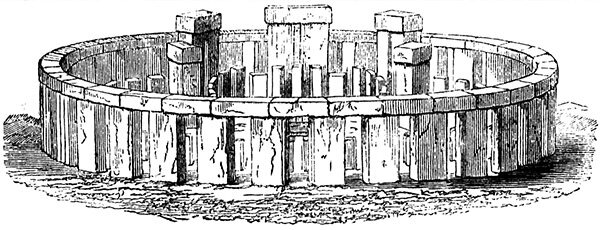
An artist’s impression of how the full structure may have looked, from Old England: A Pictorial Museum, 1845.
82 – the total number of sarsen stones that were needed for the site (10 trilithon uprights, 5 trilithon lintels, 30 circle uprights, 30 circle lintels, four Station Stones and 3 Slaughter Stones).
80 – the approximate number of bluestones that were required.
74 – the number of sarsen stones used to build the original stone circle and trilithons.
30 – the number of sarsen uprights in the original outer circle.
30 – the number of sarsen lintels that sat upon the uprights of the outer circle.
17 – the number of sarsen circle uprights that remain upright.
7 – the number of sarsen circle lintels that remain intact.
60 – the approximate number of bluestone uprights that formed the bluestone circle.
5 – the number of sarsen trilithons, arranged in a horseshoe at the centre of the stone circle.
Did You Know?
The word ‘trilithon’ comes from the Greek for “three stones”. A trilithon consists of two upright stones and a horizontal lintel atop these.
14 – the number of sarsen stones used for the trilithons (10 uprights and 4 lintels).
Did You Know?
The five trilithons were of different heights. The tallest trilithon – the Great Trilithon – was located in the middle of the 5, and faced the entrance. The two trilithons either side of this were shorter, and then the two on the outside of the horseshoe were shorter still.
3 – the number of trilithon lintels that still sit atop their uprights.
2 – the number of trilithon lintels that lie broken on the ground.
4 – the number of station stones, placed around the edge of the enclosure.
6 – the number of the bluestones found to have distinctive shapes, with grooves and holes cut into them. These will have once formed trilithons or other distinctive structures.
2-3 – the number of stones believed to have sat across the entrance route to the monument. The one remaining stone from the entrance (the so-called ‘slaughter stone’) was originally upright.
83 – the total number of stones remaining at the Stonehenge site.
43 – the number of bluestones that remain at Stonehenge.
Read More
Find out how heavy the stones are and about how Stonehenge was built.